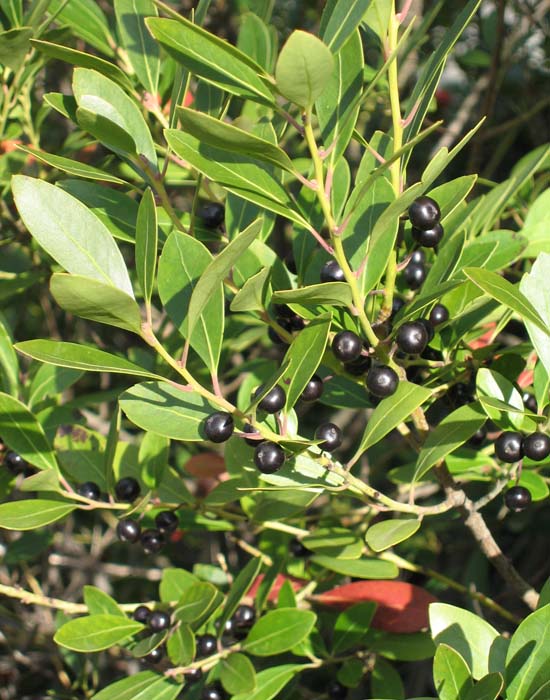Home Resources Gardener News reprints: Holly: The Other Holly
This article by Hubert Ling (NPSNJ horticulture) was published in Gardener's News without the photos. He is a regular contributing writer to Gardener's News. Photos by H & M Ling.
The Other Holly

Actually NJ has three commonly grown native hollies: there is Ilex opaca the familiar prickly holly used for decorations at Christmas, and two other not prickly hollies: Ilex verticillata, winterberry and Ilex glabra, inkberry. Inkberry holly has become so very popular with landscape architects that not many people realize that it is a common native plant growing wild in Eastern North America from Canada to Florida and is found in almost all counties of NJ. The name Ilex comes from the Latin name of the Holm Oak Quercus ilex. This oak has evergreen leaves similar to those of the hollies. The species name glabra means smooth which refers to the smooth, hairless, surface of the leaves.
Inkberry is a slow growing evergreen shrub. A mature inkberry is from 5-8’ tall and the plant generally spreads out a bit and loses lower foliage but will be bushier and more graceful if pruned. In addition, many cultivars are available and several of these are more compact such as ‘Shamrock’ or obviously ‘Compacta’. Inkberry have dark green, spineless, oval leaves (to 1.5“ long).
 Inkberry holly, female flower
Inkberry holly, female flower
Inconspicuous, greenish-white flowers appear on mature plants in spring. The nectar from these flowers produce the highly rated Gallberry honey which is popular in the Southeastern US. Male and female flowers are found on separate plants so you should have at least two plants. Female flowers are borne singly and have large protruding stigmas and small non-functional stamens. Male flowers are borne in clusters and have a ring of prominent stamens and a small sunken non-functional stigma.
The fruits are about 3/8” long and turn jet black at maturity which is where the plant gets its common name. Fruits ripen in September-October but generally persist until early spring when they may be consumed by birds with few other choices. White fruited cultivars ‘Ivory Queen’ and ‘Alba’ are also available commercially which can provide winter interest to your garden. Inkberry leaves are relatively thick and remain evergreen unless the temperature is well below zero for extended periods.
All Ilex species are mildly toxic if ingested; children should be warned not to eat the berries or leaves. This is curious since a few sources list Ilex glabra dried, roasted leaves as Appalachian tea although I could not find any original references of anyone actually using such a tea. In the absence of any hard evidence one should approach this tea idea with extreme caution since the leaves are generally free of insect bites which indicates formidable toxic, chemical defenses.
Inkberry plants do well in full sun to partial shade in a variety of soils from medium to wet and from very acid to slightly acid soils. They do not grow well under neutral or basic conditions and the foliage may burn in exposed locations. Inkberry tolerate deer, rabbits, erosion, salt, sandy soil, and air pollution. Inkberry are resistant to most pests but new shoots may be attacked by aphids. In addition, there are occasional problems with scale, spider mites, leaf miners, and the fungus Phytophthora.
Inkberry grow best naturally in partial shade around ponds, streams, and in swampy areas. Mature plants may send out suckers to produce slow growing colonies some over 100 years old. Propagation is by root cuttings taken year round and treated with commercial rooting powder. Propagation can also be done through seed but hollies are famous for the length of time required for seed germination. Under natural conditions germination times of 2 years are common. However, cleaned, freshly collected & planted seeds may germinate after 8 months in a heated greenhouse. Inkberrys are adapted to surviving in areas with frequent fires. The root crowns and rhizomes vigorously sprout after a fire and rapidly restore a burned area to full vegetation. Thus the plant is useful maintain a habitat and is occasionally browsed by bluebirds, Bobwhite, and turkeys. White tailed deer and bear may also eat inkberry.
If you are interested in an easy to grow and maintain small shrub for hedges, screens, and barriers consider inkberry. You descendants for hundreds of years may thank you for this well behaved holly.